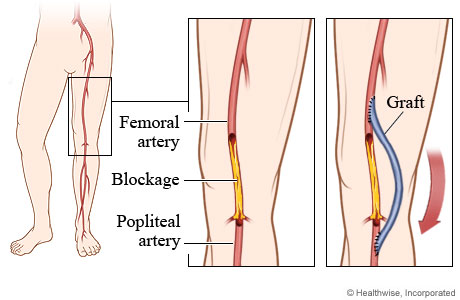Femoropopliteal Bypass Surgery
Surgery Overview
A femoropopliteal bypass is a type of surgery. It is also called a fem-pop or leg artery bypass. This type of surgery redirects blood around a narrowed or blocked blood vessel in your leg. So it may improve the blood flow in your leg. This can decrease leg pain, numbness, and cramping.
Your doctor will use something called a graft to make the blood go around (bypass) the narrowed or blocked part of your blood vessel. The graft may be a vein taken from another place in your leg. Or it may be a human-made graft.
You may be asleep during the surgery. But it also can be done while you are awake. If you are awake, you will get medicine to numb your leg and prevent pain. First, the doctor makes cuts in your thigh and sometimes in the side of the calf. These cuts are called incisions. If one of your veins is being used for the graft, the doctor will make other incisions in your leg. Then the doctor will attach one end of the graft to the femoral artery in your thigh. The other end will be attached to the popliteal artery above or below your knee. After the graft is in place and blood is flowing through it, the doctor uses stitches or staples to close the incisions. You will have scars, but they will fade with time.
You will probably stay in the hospital for at least 2 days. For at least 2 to 6 weeks, you will need to take it easy at home. It may take 6 to 12 weeks to fully recover.
How It Is Done

Femoropopliteal (fem-pop) bypass surgery is used to bypass narrowed or blocked arteries above or below the knee. The bypass improves blood flow to the leg.
To bypass a narrowed or blocked artery, blood is redirected through a graft. The graft is either a healthy blood vessel that has been transplanted or a human-made material. This graft is sewn onto both the femoral and popliteal arteries so that blood can travel through the graft and around the diseased part.
What To Expect
You will probably stay at least 2 days in the hospital.
You will have some pain from the incisions. This usually gets better after about 1 week.
Your leg may be swollen at first. This is normal. It may last 2 or 3 months.
You will need to take it easy for at least 2 to 6 weeks at home. It may take 6 to 12 weeks to fully recover.
You may need to take at least 2 to 6 weeks off from work. It depends on the type of work you do and how you feel.
You will have regular tests to check for problems with the graft.
Why It Is Done
Fem-pop bypass is for people who have narrowed or blocked femoral or popliteal arteries, which are arteries in the legs. Usually the blockage must be causing significant symptoms or be limb-threatening before bypass surgery is considered.
Learn more
How Well It Works
Fem-pop bypass surgery can improve blood flow and relieve intermittent claudication.footnote 1, footnote 2, footnote 3
Risks
All surgeries carry a certain amount of risk. These risks include:
- Infection.
- Bleeding.
- Heart attack or stroke.
Specific risks for this bypass surgery include:
- Leg swelling.
- Failed or blocked grafts.
References
Citations
- Conte MS, et al. (2019). Global vascular guidelines on the management of chronic limb-threatening ischemia. Journal of Vascular Surgery, 69(6S): 3S–125S.e40. DOI: 10.1016/j.jvs.2019.02.016. Accessed June 1, 2023.
- Gerhard-Herman MD, et al. (2016). 2016 AHA/ACC guideline on the management of patients with lower extremity peripheral artery disease. Circulation, published online November 13, 2016. DOI: 10.1161/CIR.0000000000000471. Accessed November 25, 2016.
- Conte M, et al. (2015). Society for Vascular Surgery practice guidelines for atherosclerotic occlusive disease of the lower extremities: Management of asymptomatic disease and claudication. Journal of Vascular Surgery, 61(3S): 2S–41S. DOI: 10.1016/j.jvs.2014.12.009. Accessed November 25, 2016.
Credits
Current as of: October 2, 2025
Author: Ignite Healthwise, LLC Staff
Clinical Review Board
All Ignite Healthwise, LLC education is reviewed by a team that includes physicians, nurses, advanced practitioners, registered dieticians, and other healthcare professionals.
Current as of: October 2, 2025
Author: Ignite Healthwise, LLC Staff
Clinical Review Board
All Ignite Healthwise, LLC education is reviewed by a team that includes physicians, nurses, advanced practitioners, registered dieticians, and other healthcare professionals.